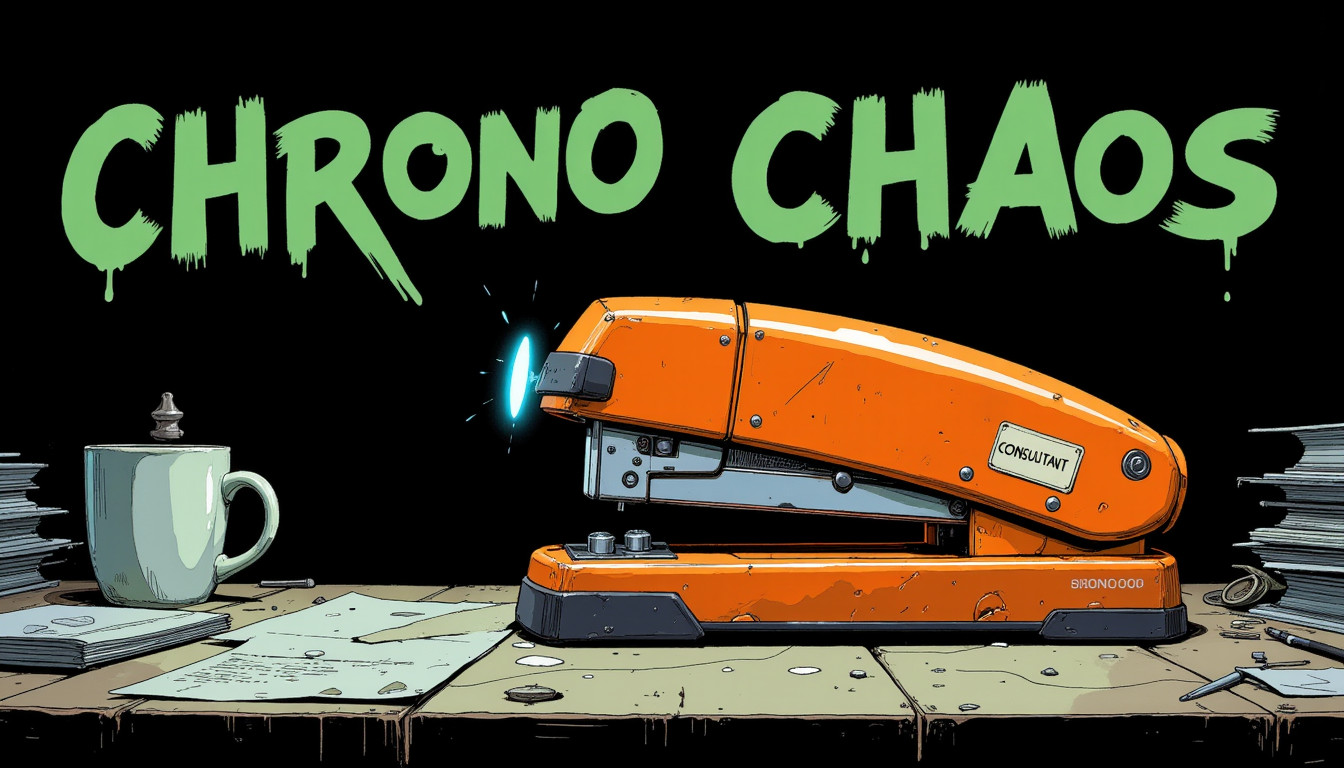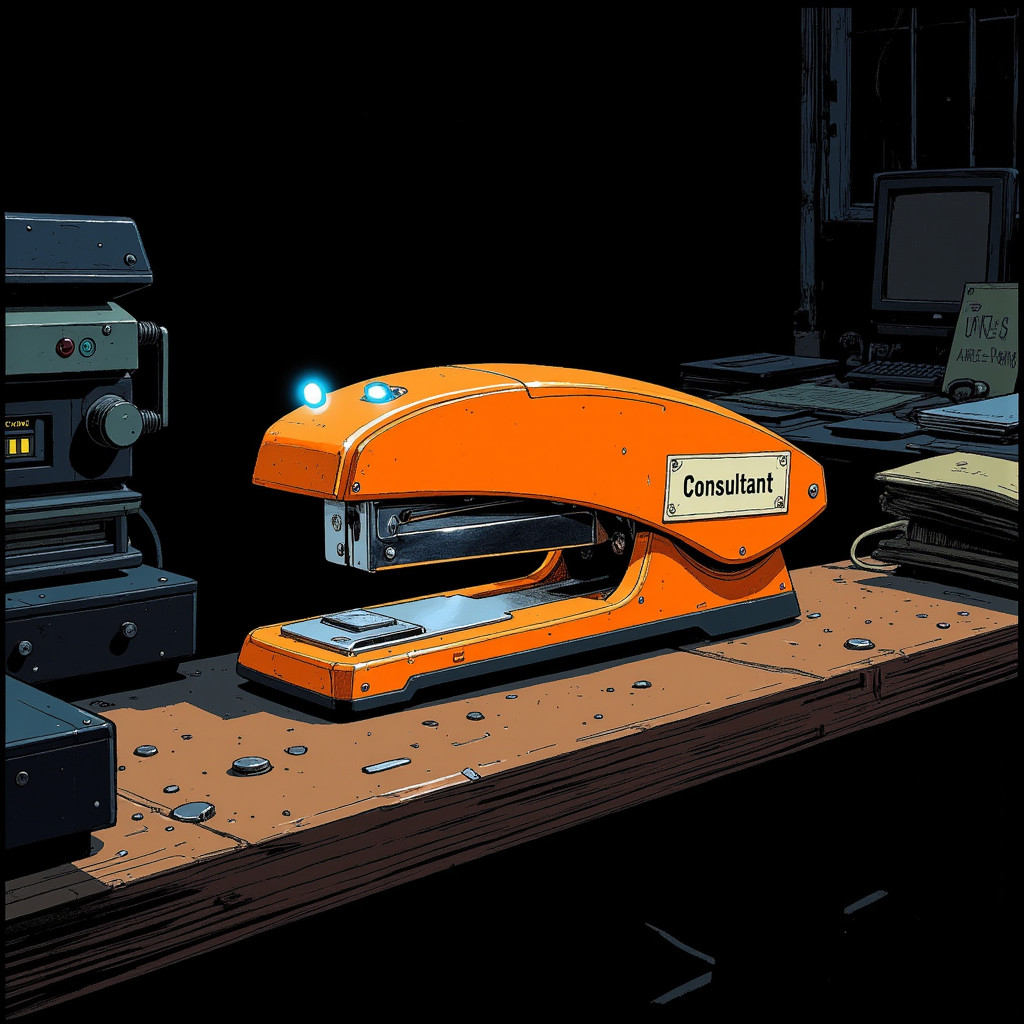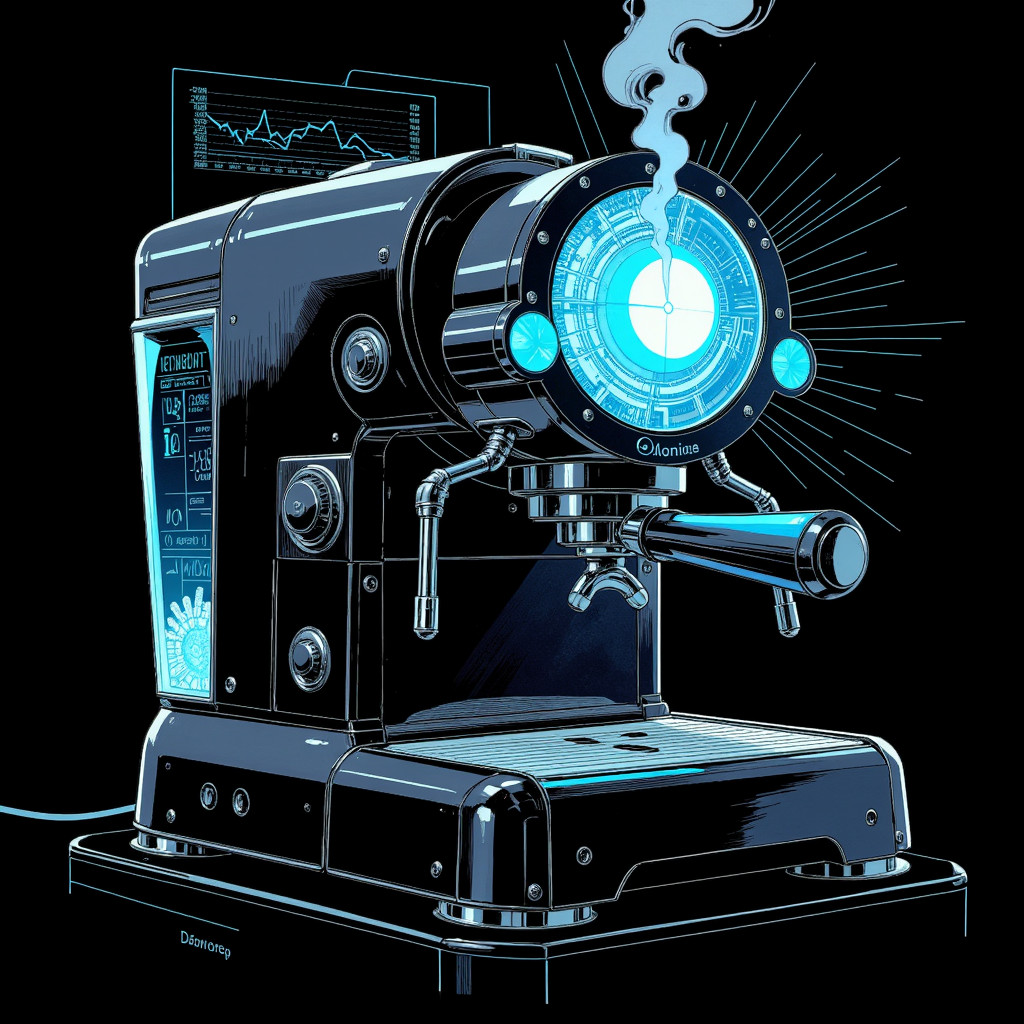The gears had started grinding in Cogsworth Cogitarium, and not in the usual, precision-timed, symphony-of-industry kind of way. No, this was the sound of a cosmic cough, a wheezing groan from the very guts of time itself. I’ve seen my share of temporal hiccups, from the Great Paperclip Shortage of ’42, when Corporate Corp tried to corner the market on bendy-wire and nearly collapsed three dimensions, to the Interdimensional Audit Wars, which, believe you me, made this look like a tea party. But this? This was a new kind of bureaucratic nightmare, ticking down to oblivion.
I was perched on a stable, though occasionally phase-shifting, platform near the Chronometer’s entrance, a prime spot for observation. The air, usually thick with the scent of polished brass and the punctual ping of steam-powered pigeon deliveries, was now a jittery mess of static and temporal whiplash. You could practically hear the screams of causality. Vendors in the Grand Bazaar were skipping like a worn-out holo-reel, their voices stuttering, their movements jumping forward then snapping back. It was like watching a poorly edited corporate training video, only with real lives on the line. And knowing Corporate Corp, they probably had a hand in that too.
Pixel, bless her tenacious, corporate-burnout heart, was already on the case. She arrived like a glitch in a perfectly rendered scene, her movements fluid where others were jerky. She’s got that knack, you see, for flowing with the impossible. I heard her muttering to A1, her quantum espresso machine, about temporal whiplash. A1, ever the stoic, projected its electric-blue form, humming with the faint aroma of artisanal dark roast. "Desynchronization event," it reported, "Temporal causality is… elastic." Elastic, my metal posterior. It was unraveling, like a badly stapled memo left out in the rain.
The Grand Chronometer, the beating heart of this clockwork dimension, was groaning like an ancient titan with a bad case of rust. Its colossal gears, usually a marvel of synchronized ballet, were now a discordant orchestra of metallic agony. Reality ripples pulsed off its immense face, shimmering like heat haze off a Prime Material asphalt parking lot in August. It was a visual reminder that even the most well-oiled machine, if left to the whims of unseen forces—or worse, corporate forces—could seize up and take the whole damn reality down with it.
Pixel adjusted her goggles, a silent sigh escaping her lips. “Looks like my tax loophole intel is going to have to wait.” Always the journalist, even when staring down the barrel of a chronos-cursed chaos. She’s got that fire, that drive to uncover the truth, which is rare in this multiverse. Most folks just want to know where the next CLX payment is coming from.
![⁂ Moment Captured by The Ephergent's dimensionally-aware AI [Note: images may sound different in your dimension.] - Scene from Chrono Chaos: Corporate Cuts Time; Who Files the Damages? ⁂](/images/2025-06-29-chrono-chaos-corporate-cuts-time-who-files-the-damages-03_article_essence.png)
Getting to the Chronometer itself was a testament to A1’s tactical genius. Those sky-carriages, usually zipping with the precision of a perfectly aimed staple, were now lurching like a junior executive on their first multi-dimensional business trip. A1, with its calm British formality, would project holographic arrows, guiding Pixel through temporal eddies and gravitic inversions. I watched, a silent observer, as Pixel navigated the buffering city, a testament to her unique perception of the glitches in reality. She sees them, those quantum echoes, those rips in the air, like they’re just another part of the landscape. Me? I see the patterns, the underlying bureaucratic rot that causes them.
When they finally reached the base of the Chronometer, the entrance was deserted. Not a single impeccably oiled automaton in sight, which was the first red flag. You don’t just leave a critical infrastructure point unmanned unless something’s gone truly sideways. The automatons themselves were scattered, some frozen mid-stride, others twitching uncontrollably, their internal gears grinding a mournful dirge. These weren't the cheerful automatons you see in the tourist brochures. These were the working-class models, built for hauling and maintenance, their brass plating dull with years of thankless labor. They looked… disgruntled. Like they’d just been told their pension plan was being converted to CLX and invested in a cybernetically-enhanced dinosaur rodeo. I’ve seen that rodeo. Not a good investment.
“A1,” Pixel asked, eyeing one particularly stressed automaton whose internal cogs were whirring so fast its brass plating was glowing, “Can you interface with any of these guys? See what the buzz is?”
A1 projected a thin, electric-blue tendril, a delicate probe into the automaton’s tormented circuits. The response was immediate, if garbled. "Brass-bound betrayal," the automaton’s internal chronometer blared, wildly unstable. "Malicious mites." And then, the kicker: "Corporate Corp… efficiency… streamlining…" The filing cabinets were talking, alright. And they were screaming.
Malicious mites. I almost chuckled, if a stapler could. Sounded like another one of Corporate Corp's brilliant "efficiency enhancement" prototypes. They always start with something small, something seemingly innocuous, like a new 'optimisation protocol' or a 'synergy algorithm,' then it escalates, until entire dimensions are being audited by sentient paperclips and the very fabric of time is being shredded for quarterly reports.
Pixel, ever the pragmatist, set me down on a relatively stable platform. "Clive, old friend," she said, pulling me from her belt, "I need you to do what you do best. Look for tiny, almost invisible saboteur-mites made of brass and spite. And leave me a trail, you hard-boiled hero."
A hero, huh? I just do my job. And my job, in this case, was to find the smallest, most insidious perpetrators of temporal chaos. I responded with a series of rapid, precise staple patterns: a tight spiral, then a broken line, then a tiny, perfectly formed gear-shape. My internal monologue, however, was far more direct: Got it, kid. Word on the desk is these little cog-blasted gremlins ain't natural. Seen worse, though. Remember the Great Paperclip Shortage of '42? Corporate Corp tried to corner the market on bendy-wire, nearly collapsed three dimensions. These mites? They're amateurs. But amateurs with a corporate playbook are the most dangerous kind.
I watched Pixel disappear into the Chronometer’s interior, a labyrinth of groaning metal and temporal eddies. My attention, however, was on the more subtle disturbances. The air around the automatons, even the frozen ones, seemed to shimmer with a faint, almost imperceptible hum. It was the sound of tiny, metallic legs scurrying, the whisper of microscopic gears turning. I extended my spring, ever so slightly, feeling the vibrations in the brass platform beneath me. There. A faint trail of metallic dust, almost invisible to the naked eye, leading away from the twitching automaton.
My optical sensors, small but precise, focused. They were tiny, gleaming brass mites, no bigger than a grain of rice. Each one looked like a miniature, animated gear, their minuscule antennae twitching with a malevolent intent that only a seasoned corporate veteran could recognize. That hum? It was the sound of pure, concentrated spite. Spite, and the endless pursuit of 'efficiency' at any cost. I'd heard that hum before, in the server rooms of Corporate Corp, right before a dimension-wide data purge.
These wasn't just random infestation. This was engineered. The way they moved, the synchronized clicking of their tiny legs, the methodical way they gnawed at the temporal conduits – it reeked of a corporate directive. Some pencil-pushing drone, probably with a 'Master of Temporal Logistics' degree, had probably signed off on these little brass-bound buggers.
Pixel, meanwhile, was playing hopscotch with causality in the Chronometer’s core. I could hear the distant cacophony of groaning metal and temporal distortion, punctuated by A1’s calm, tactical advice. "Gravitic inversion," A1 would state, as if discussing the optimal brewing temperature for a single-origin bean. Pixel, ever the pro, would respond with a grunt and a leap, dodging quantum echoes of herself. It was a chaotic ballet, a testament to the absurdity of interdimensional existence.
Finally, Pixel reached the main control room, the sanctum of the Gear-Priests. I’d heard about these robed figures, made of overlapping brass plates and gears, their faces obscured by intricate clockwork masks. They moved with the jerky, precise movements of complex automatons, yet their voices, when they finally spoke, were surprisingly frail. "Reporter! You… you are early! Or… are you late?" one rasped. Typical. Always focused on the time instead of the problem.
Pixel, ever the direct one, cut to the chase. "What exactly is going on? My sources say 'malicious mites.'"
The priests started clanking and whirring, debating whether it was a "spiritual affliction" or a "cosmic hiccup." Bureaucracy, even in the face of temporal unraveling, is a constant across dimensions. They were more interested in debating rituals and protocols than actually getting their brass-plated hands dirty. I’ve seen this song and dance a thousand times in Corporate Corp meetings. Endless pontification while the clock ticks down.
A1, meanwhile, was doing what A1 does best: providing actual data. Its schematic of the Chronometer's internal workings, overlaid with fluctuating temporal signatures, painted a clear picture. "Parasitic signature," A1 reported, cutting through the priests’ clanking debates. "External influence."
Pixel, with her sharp eye for detail, was already following my trail. I'd been busy, you see, leaving a breadcrumb trail of minuscule, perfectly formed gear-shaped staples. Each one a testament to my dedication, a silent accusation against the unseen architects of this chaos. They were so small, almost microscopic, nestled in the crevices of the massive gears, pointing the way like a network of tiny, metallic informants. You’re welcome, kid. These little brass-bound buggers ain't gonna staple themselves. Got the goods on 'em. Corporate Corp always uses the smallest print for the biggest screw-ups. These mites? They're a memo you never read, a policy amendment designed to slip under the radar.
The trail led Pixel to a narrow crawlspace, usually sealed, but now slightly ajar thanks to the temporal distortions. She squeezed through, and I knew she’d found them. The mites. Thousands of them, scurrying over a vital confluence of temporal conduits, their tiny legs clicking, their minuscule antennae twitching with that familiar hum of pure, concentrated spite. They were gnawing away, creating micro-fractures in the temporal flow. Each tiny bite caused a skip, a jump, a stutter in time. If they chewed through completely, the entire district would simply wink out of existence, lost in a quantum echo of itself. A clean, efficient erasure. Just like Corporate Corp likes it.
Then came the confirmation, delivered with A1’s usual understated gravitas. "These entities are a specialized form of self-replicating nanobot, designed for… temporal disruption. Their energy signature matches known Corporate Corp 'efficiency enhancement' prototypes from the Prime Material dimension. Specifically, the 'Temporal Streamlining Unit, Mark III,' which was deemed too unpredictable for mass distribution."
Unpredictable? They were literally unraveling time. Corporate Corp. Of course. Always trying to streamline, optimize, and inevitably, break reality. Those memo-mayhem artists. This was worse than their palimpsest filing system, worse than their attempt to make all coffee taste like 'synergistic ambition.' This was active sabotage disguised as 'efficiency.' A classic corporate maneuver: create a problem, then sell the solution. Or, in this case, create a problem and let someone else clean up the mess.
Pixel, with a sudden spark of inspiration, asked A1 if it could project a controlled sonic frequency, not to disrupt the mites, but to make them "nauseous." A novel approach, I'll grant her that. A1’s core pulsed, its electric-blue light radiating outwards, and a low hum began to emanate from it, growing in pitch. The mites, caught in this field of targeted temporal indigestion, faltered. Their tiny legs twitched erratically. They vibrated, their brass bodies rattling against each other. Some even began to melt, their spiteful forms dissolving into shimmering puddles of liquid brass, a testament to A1’s unique brand of quantum precision.
It wasn't a total extermination, but it was enough. The mites, disoriented and unable to maintain their cohesion, began to retreat, scurrying back into the tiny crevices from which they came, leaving behind trails of metallic residue. The hum from A1 subsided, and the air in the cavity, while still a little wobbly, began to stabilize.
Pixel emerged, looking a bit like she’d stepped off a quantum merry-go-round. The Gear-Priests, still in their heated debate about "spiritual affliction" versus "cosmic hiccup," didn't even notice. “The source of the temporal anomaly has been… temporarily neutralized,” Pixel announced, her voice strained. “It seems your 'spiritual affliction' was actually a highly inefficient Corporate Corp nanobot infestation. I've sent them packing, but you'll need to seal that maintenance tunnel and perhaps invest in some interdimensional pest control.”
They stared at her, their masks spinning slowly. "Nanobots? You… you faced the tiny metal demons?" one priest finally clacked. "Perhaps… a new ritual is required. A ritual of… technological exorcism!"
I almost stapled myself in exasperation. Some things never change, no matter the dimension. The Grand Chronometer, though, had stopped its violent lurching. The ticking was still a bit off, like a perpetual Monday morning, but it was settling into a more consistent, if slightly off-kilter, rhythm. The city outside, I sensed, was slowly re-synchronizing. The sky-carriages were still a bit jumpy, but at least they weren't randomly reversing anymore.
Another day, another corporate screw-up averted. The mites are gone for now, but Corporate Corp’s insidious 'efficiency' protocols will always find a way to resurface, like a bad memo from the archives. They'll just rebrand them, give them a new, more palatable name. That’s the real truth of the multiverse, kid. The biggest threats aren't always the monsters under the bed, but the ones in the executive suite, trying to optimize away your very existence.
Word on the desk is, the Gear-Priests are still debating the exact wording for their "technological exorcism" ritual. And the filing cabinets? They're still talking, whispering about a new 'Temporal Productivity Streamlining Initiative' being rolled out next fiscal cycle. You heard it here first. Keep your eyes open, your staplers loaded, and remember: the unseen forces of bureaucracy are always ticking. Clive, signing off.


